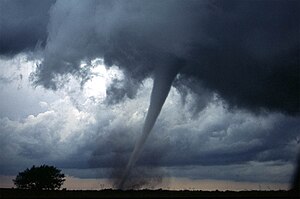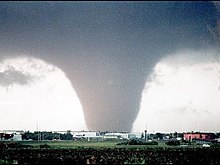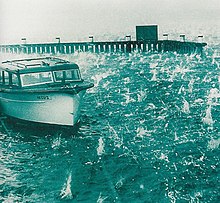Note: Tornadoes are very dangerous and potentially deadly. Always take tornado warnings seriously and immediately seek shelter. |
The Tornadoes Portal

Selected tornado article -
The 1947 Sydney hailstorm was a natural disaster which struck Sydney, Australia, on 1 January 1947. The storm cell developed on the morning of New Year's Day, a public holiday in Australia, over the Blue Mountains, hitting the city and dissipating east of Bondi in the mid-afternoon. At the time, it was the most severe storm to strike the city since recorded observations began in 1792.
The high humidity, temperatures and weather patterns of Sydney increased the strength of the storm. The cost of damages from the storm were, at the time, approximately £750,000 (US$3 million); this is the equivalent of around A$45 million in modern figures. The supercell dropped hailstones larger than 8 centimetres (3.1 in) in diameter, with the most significant damage occurring in the central business district and eastern suburbs of Sydney. (Full article...)
Selected tornado list -

This page lists tornadoes and tornado outbreaks which have touched down in Canada prior to the 21st century. On average, there are around 80 confirmed and unconfirmed tornadoes that touch down in Canada each year, with most occurring in the southern Canadian Prairies, Southern Ontario and southern Quebec. Canada ranks as the country with the second most tornadoes per year, after the US. The most common types are F0 to F2 in damage intensity level and usually result in minor structural damage to barns, wood fences, roof shingles, chimneys, uprooted or snapped tree limbs and downed power lines. Fewer than 5% of tornadoes in Canada are rated F3 or higher in intensity, where wind speeds are in excess of 225 km/h (140 mph). Prior to April 1, 2013, Canada used a slightly modified Fujita scale, and as of that date the Enhanced Fujita scale, again slightly modified, was put into use to rate tornado intensity, based on the damage to buildings and vegetation.
Each year on average, about 43 tornadoes occur across the Canadian Prairies and about 17 occur across Ontario and Quebec. New Brunswick and the British Columbia Interior are also recognized tornado zones. All other provinces and territories have significantly less threat from tornadoes. The peak season in Canada is through the summer months, (June to August), when clashing air masses move north, as opposed to the spring season in the United States southern-central plains, although tornadoes in Canada have occurred in spring, fall and very rarely winter. (Full article...)
Selected image -

Selected tornado year -
This page documents the tornadoes and tornado outbreaks of 1953, primarily in the United States. Most tornadoes form in the U.S., although some events may take place internationally. Tornado statistics for older years like this often appear significantly lower than modern years due to fewer reports or confirmed tornadoes. This was the first year to record an F5 tornado as well as one of the deadliest tornado seasons in official U.S. records, which go back to 1950.
The total count of tornadoes and ratings differs from various agencies accordingly. The article, therefore, documents information from the most contemporary official sources alongside assessments from tornado historian Thomas P. Grazulis. (Full article...)
Related portals
2024 tornado activity
A significant early spring tornado outbreak occurred throughout the Midwestern and Northeastern United States, with the most significant impacts occurring in Indiana and Ohio. More than two dozen tornadoes occurred, eight of them strong to intense. National Weather Service offices issued multiple 'Particularly Dangerous Situation' tornado warnings. Strong tornadoes produced major damage in the communities of Selma and Winchester in Indiana, and Fryburg and Lakeview in Ohio. One person died in Winchester, and three people were killed in Lakeview. Other significant tornadoes caused damage in Kansas, Arkansas, and Kentucky, with scattered weak tornadoes confirmed in several other states.
In addition to tornadoes, severe weather occurred across the West and East South Central U.S. Damaging winds and large hail was reported in Oklahoma, Missouri, and parts of the Deep South. Heavy rainfall and flash flooding was reported in Tennessee and Kentucky. (Full article...)
List of 2024 tornado articles
|
|---|
Tornado anniversaries
November 8
- 1879 – A tornado family with members up to F3 intensity hit Strasburg and Page City, Missouri. Two people died in Page City, where six of the twelve homes, a store, and a railroad depot were destroyed. An F2 tornado killed one person near Fort Smith, Arkansas.
- 1989 – An F2 tornado destroyed several homes and trailers in Pineview, Georgia. A child was killed in a trailer that was thrown 200 feet (61 m) and eight other people were injured.
- 1996 – An F2 tornado lifted an unanchored mobile home near Chester, Georgia, killing a child and injuring six family members. Victims were carriedup to 200 yards (about 200 meters).
November 9
- 1864 – One of few known tornadoes from during the American Civil War hit Chester and Richview, Illinois at about 2:00 AM, killing at least five people, including four in Chester. There were rumors of up to 20 deaths. A ferry on the Mississippi River was destroyed with only the hull, engine, and boilers left behind.
- 1926 – An estimated F3 tornado struck La Plata, Maryland, killing 17 people and injuring 65. Fourteen deaths were in a school that was thrown into a grove of trees and destroyed.
November 10
- 1915 – A tornado outbreak affected the Midwestern United States with the worst impacts in Kansas. An F4 tornado destroyed 160 homes in Great Bend, Kansas, killing 11 people and injuring 75. Debris was carried 85 miles (137 km). At least 1000 sheep were killed, and dead ducks fell from the sky near Claflin, Kansas. Another F4 tornado killed four people in Zyba and Derby, Kansas.
- 1957 – One of Japan's deadliest tornadoes hit Tomiye City in [[Nagasaki Prefecture, killing six people.
- 2002 – The second day of a three-day tornado outbreak had its worst impacts across the Midwestern and Eastern United States, resulting in 32 deaths. An F3 tornado devastated Mossy Grove and Joyner, Tennessee, killing seven people and injuring 28. A long-track F3 tornado traveled 72 miles (116 km) across northern Alabama; all 7 deaths and 40 injuries were along a 10-mile (16 km) stretch in and near Saragossa. An F4 tornado, up to half a mile (0.8 km) wide, hit Van Wert and Roselms, Ohio, killing four people. Only one structure in Roselms was left standing.
Did you know…
- ...that the 2013 Moore tornado that struck Moore and Newcastle, Oklahoma, is the most recent EF5 tornado?
- ...that the 2021 South Moravia tornado, an IF4 tornado with winds between 207–260 mph (333–418 km/h), was the strongest tornado to hit the Czech Republic in modern history?
General images -
The 1999 Sydney hailstorm was the costliest natural disaster in Australian insurance history, causing extensive damage along the east coast of New South Wales. The storm developed south of Sydney on the afternoon of Wednesday, 14 April 1999, and struck the city's eastern suburbs, including the central business district, later that evening.
The storm dropped an estimated 500,000 tonnes of hailstones in its path. The insured damage bill caused by the storm was over A$1.7 billion (equivalent to $3.8 billion in 2022), with the total bill (including uninsured damage) estimated to be around $2.3 billion. It was the costliest single natural disaster in Australian history in insured damage, surpassing the $1.1 billion in insured damage caused by the 1989 Newcastle earthquake. Lightning also claimed one life during the storm, and the event caused approximately 50 injuries. (Full article...)
Topics
Subcategories
Related WikiProjects
The scope of WikiProject Severe weather is to write articles about severe weather, namely thunderstorms and tornadoes. Their talk page is located here.
WikiProject Weather is the main hub for all articles that are weather-related. WikiProject Weather strives to improve articles in a variety of weather topics, including Tropical Cyclones, Severe Weather, General meteorology, Non-tropical Storms, Climate, Floods, Droughts and wildfires, Meteorological instruments and data, Meteorological Biographies, and Space Weather. If you would like to help, please visit the project talk page.
WikiProject Meteorology is a collaborative effort by dozens of Wikipedians to improve the quality of meteorology- and weather-related articles. If you would like to help, visit the project talk page, and see what needs doing. The project is currently being merged into WikiProject Weather.
WikiProject Tropical cyclones is a daughter project of WikiProject meteorology. The dozens of semi-active members and several full-time members focus on improving Wikipedia's coverage of tropical cyclones.
Wikipedia is a fully collaborative effort by volunteers. So if you see something you think you can improve, be bold and get to editing! We appreciate any help you can provide!
Things you can do
Wikimedia
The following Wikimedia Foundation sister projects provide more on this subject:
-
Commons
Free media repository -
Wikibooks
Free textbooks and manuals -
Wikidata
Free knowledge base -
Wikinews
Free-content news -
Wikiquote
Collection of quotations -
Wikisource
Free-content library -
Wikiversity
Free learning tools -
Wikivoyage
Free travel guide -
Wiktionary
Dictionary and thesaurus









































